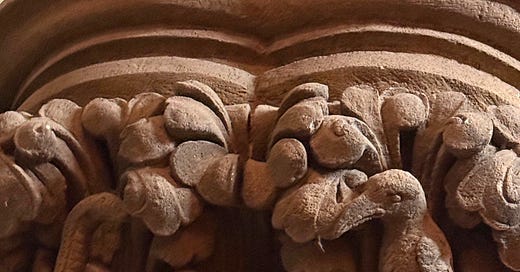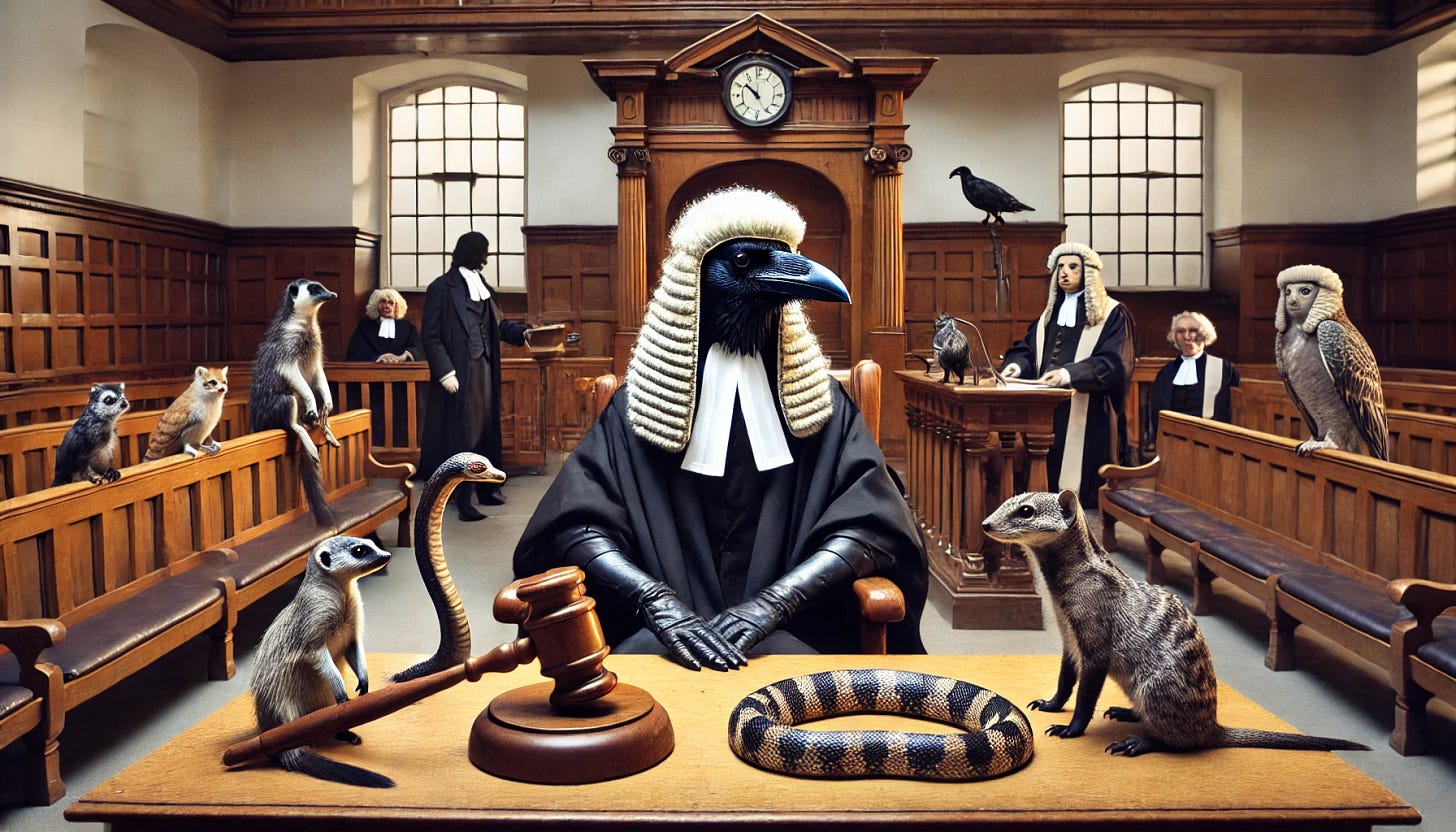Deep within the hallowed halls of Bombay High Court, perched, I think, on Pillar No. 7, a historic courtroom drama has been immortalised with the above image in stone.
Circa 1853, in the UK Court of Forest Justice, a small but mighty Mongoose filed a case under The Cruelty to Animals Act of 1849. The defendant, Snake, claimed that Mongoose had been trespassing on his territory and eyeing his dinner uninvited. Snake, naturally, hissing his claim, accused Mongoose of harassment and attempted lunch theft.
This eternal battle of predator and prey came before the Honourable Judge Mr. Victor B. Crow, known for his cold and calculated stare and stern demeanour. His courtroom, carved in stone, has one unbreakable rule: Whoever loses gets to feed the court fees—literally.
And the trial began.
Mongoose passionately presented evidence—a chewed corner of his fur (allegedly Snake's doing) and a witness statement from the local squirrel (whose testimony was quickly discredited for being "nuts"). He further claimed that the defendant Snake’s area was unmarked, open and in public domain. The defendant, on the other hand, slyly slithered his way into technicalities, claiming his area has been determined by the first officials, and their testimony be recorded.
Judge Crow listened silently, occasionally glancing at the lunch buffet below the pillar. He declined summoning the forest officials because he knew how corrupt and sinister these Govt. Officials are.
As news of the trial spread, it stirred an uproar among animal rights activists. A flock of pigeons, self-proclaimed environmentalists, picketed just outside the Courtroom, cooing slogans like, “Feathers for fairness!” and “No scales, no bias!” They accused Judge Crow of siding with his "natural ally" the Mongoose, pointing out that crows often scavenge leftovers from mongoose hunts.
The Judge Crow threatened that he will order a Jury trial by 50 Crows.
Meanwhile, a peacock—a self-proclaimed attorney renowned for his dramatic flair—volunteered to act as amicus curiae. Strutting in with his plume fully fanned, he declared, “Your Honor, I shall bring clarity to this case. It is a matter of national heritage that all disputes in the forest must be mediated fairly. After all, what is justice if there is no dance of truth and feathers?”
Judge Crow rolled his beady eyes but allowed the peacock to present his argument, mostly because he was curious about how the bird planned to make this all about himself.
The peacock argued eloquently: “Both the mongoose and the snake are integral parts of the ecosystem. Punishing either would disrupt the natural order. However, I propose a compromise. If they must be punished, let them be immortalised as a lesson in harmony and conflict resolution. And to ensure fairness, his image be carved onto this pillar as a symbol of impartiality and truth.”
Sensing a PR opportunity, Judge Crow agreed to the peacock’s proposition, but with one caveat: “Only if you waive your exorbitant speaking fees, Mr. Peacock.”
The Protest Escalated.
Outside, the pigeons’ protests grew louder. A gang of squirrels joined in, wielding tiny placards that read, “We demand ‘nut-ural’ justice!” and “Crows can’t rule!” Things turned ugly when a group of activist monkeys, always eager to escalate drama, started flinging fruits. The forest court, now teetering on chaos, became the talk of the town.
Tired of the commotion, Judge Crow, made a landmark decision to call for mediation. He appointed an Owl—wise, nocturnal, and thoroughly uninterested in both snakes and mongooses—as the mediator. The Owl after hearing all sides (and taking several long naps between the proceedings), suggested a creative solution: “Let the sculptor immortalise not just the litigants but the entire ecosystem’s contribution to this story.”
Finally, the Court declared both guilty. Mongoose for trespassing, and the Snake, for assault. The punishment? They must compensate the court. As Crow delivered the sentence, a gleam in his eye suggested that he had no intention of letting either go scot-free. After all, crows are known to feast on leftovers, and this was a banquet served with drama.
As the sculpture fades into eternity, it reminds us of one simple truth: Whether predator or prey, in court, both parties leave lighter—either in pocket, pride, or in this case, body parts.
The Verdict
And so, the final sculpture was commissioned. Alongside the Mongoose and Snake locked in eternal combat, Judge Crow watching their conduct majestically.
It was further declared that any new Court building that would get commissioned post this judgment should have at least one pillar depicting this sculpture:
There was a demand that at the base of the pillar, the images of activist groups of pigeons, squirrels, the fruit-flinging monkeys should be depicted, with the wise owl perched above, watching over them all. And, of course, the image of the senior attorney, peacock. Judge Crow dismissed all these requests.
The activists [in recent years being labelled as ‘Lobbyists’], however, always wanted to be anonymous, declare victory and disperse. Thanking the Court for not adding them to the pillar for posterity, the forest officials slithered away into obscurity, which they are notorious for.
Thus, Pillar No.7 of the Bombay High Court depicts the above sculpture. (It is likely that buildings of the other two High Courts of Calcutta and Madras have similar pillar)
Moral of the Story:
1. Even the fiercest battles can find resolution—if everyone agrees to share the credit.
2. Sometimes, lobbyists take part in moving the wheels of justice.
3. Justice may be blind, but it is also deeply diplomatic, and occasionally dramatic.
After the pigeons picketing, peacocks pleading, and the monkeys making a mess, it became clear that justice is not just about verdicts, it is about making everyone feel important. And that, dear friends, is how Bombay High Court’s Pillar No. 7 became the most democratic stone carving in history.
Do you think the court matters get resolved like this? It started another debate?
What happened then?
As the dust settled on the Mongoose vs. Snake case, the sculptor had barely put down his chisel when murmurs arose from the legal pigeons perched nearby. “Sure, it’s a landmark case,” cooed one pigeon in a smug tone, “but should it be labelled reportable? After all, this is forest law, not something the humans can relate to!”
Judge Crow, overhearing this, puffed his chest. “Of course, it is reportable. This judgment will inspire generations—humans, animals, and even stone sculptors. It is an exemplary case of ecosystem-wide justice,” he thundered. After all, he should get the credit.
But not everyone agreed. The forest’s self-styled legal committee (comprising a squirrel, a retired turtle, and an argumentative parrot) gathered to debate the issue and seek ‘the opinion’ from the Local Commissioner, which was unwarranted but politically required.
Arguments for ‘Reportable’
1. The Precedent:
“Never before has a single judgment managed to balance predators, prey, activists, AND bureaucrats. If this is not precedent-setting, what is?” argued the peacock, whose feathers now gleamed with pride.
2. The Public Interest Angle:
“This case demonstrates what happens when natural justice meets procedural law—and bananas. The people (and animals) need to know!” cawed a crow journalist from The Feathered Times.
3. The Dramatic Appeal:
“If humans can write entire books on the UK’s 1843 Judicature Act, why not immortalise the first legal protest involving fruit-flinging monkeys?” quipped the monkeys.
Arguments for ‘Non-Reportable’
1. Too Localized:
The retired turtle raised a wrinkly paw and said, “This is a forest-specific matter. How will city-dwelling pigeons or park squirrels benefit from such a niche ruling? It is hardly relevant outside these woods.”
2. Over-Dramatized:
“Let’s face it” huffed a sceptical pigeon. “This was less about justice and more about Judge Crow securing his legacy. We cannot encourage more show-birdship in the judiciary.”
3. The Risk of Bad Precedents:
The squirrel waved a nut passionately. “What if this sets a trend? Next thing you know peacocks everywhere will start demanding their fees and sculptures! This ruling could spark ego wars!”
Declaration
After a heated debate, Judge Crow issued his final classification. “In the spirit of balancing justice, legacy and difficult times that may ensue, my verdict shall be labelled:
Conditionally Reportable
Clause 1: If referenced by legal scholars or activists trying to prove that justice transcends species, it is reportable.
Clause 2: If used by litigants seeking to waste the court’s time with their petty squabbles, it is non-reportable.
Clause 3: Under no circumstances shall this judgment be referenced during marital disputes—because no one wins those anyway.”
The forest erupted into laughter (and a few peacock selfies). Thus, the case was both etched in stone and left open to interpretation—a fitting compromise for an immortal ruling.
Moral of the Labelling Drama:
1. Justice is not just about right or wrong, it is also about legacy.
2. Some judgments are reportable only if they come with a great story—and a carved pillar.
3. Even a crow knows when to hedge his bets.
Disclaimer: While the above carving on one of the pillars of the Bombay High Court building is reported genuine, the background of the court proceedings is nothing but conjectural surmises of this, yours truly, “Distinguished and Scholarly” Case Reporter.
Now in the name of the Justice, it is your turn to
Thank you for your time and reading.







https://substack.com/profile/293420365-federico-soto-del-alba/note/c-91163367